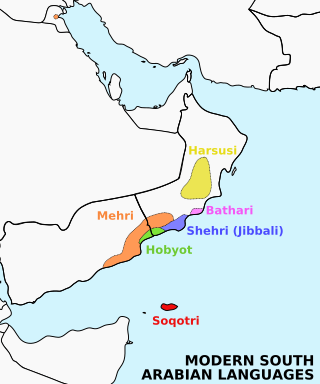User:Zbwhite1/sandbox
| Harsusi | |
|---|---|
| Harsiyyet | |
| Pronunciation | [ħarsuːsi] |
| Native to | Oman |
| Region | Jiddat al-Harasis, Dhofar Province |
Native speakers | 600-1000[1] (2011) |
| Language codes | |
| ISO 639-3 | hss |
| Glottolog | hars1241 |
 | |
Harsusi (also known as Ḥarsūsī, Harsiyyet, Hersyet, or Harsi `Aforit) is a Semitic language of Oman, spoken by the Harasis people. It is classified as a moribund language,[2] with an estimated 600-1000 speakers in Jiddat al-Harasis, a stony desert in south-central Oman. It is closely related to Mehri.[3]
General information
[edit]Harsusi first came to the attention of outside scholars in 1937, when it was mentioned by Bertram Thomas in his book Four Strange Tongues of South Arabia.[2] While certain scholars have claimed that Harsusi is a dialect of the more widely-spoken Mehri language,[4] most maintain that they are mutually intelligible but separate languages .[5] Harsusi, like all the Modern South Arabian languages, is unwritten,[2] though there have been recent efforts to create a written form using an Arabic-based script.[1]
Because the Harasis people were for centuries the only human inhabitants of Jiddat al-Harasis, the language developed in relative isolation.[6] Yet growing contact with neighboring communities due to increasing work in the local oil industry and Arabic-language education[2] has led to the language having more influence from Arabic,[7] as well as many Harasis learning Arabic and Mehri in addition to or in place of Harsusi.
UNESCO has categorised Harsusi as a language that is "definitely endangered".[8]
References
[edit]- ^ a b Eades, D. "The documentation and ethnolinguistic analysis of Modern South Arabian: Harsusi." Endangered Languages Archive.
- ^ a b c d Morris, M. 2007. "The pre-literate, non-Arabic languages of Oman and Yemen." Lecture conducted from Anglo-Omani and British-Yemeni Societies.
- ^ Peterson, J.E. "Oman's Diverse Society: Southern Oman." In: Middle East Journal 58.2, 254-269.
- ^ Maisel, S., and Shoup, J. 2009. Saudi Arabia and the Gulf Arab States Today: An Encyclopedia of Life in the Arab States. Westport, Conn.: Greenwood Press.
- ^ Peterson, J.E. "Oman's Diverse Society: Southern Oman." In: Middle East Journal 58.2, 254-269.
- ^ Chatty, D. 2013. “Negotiating Authenticity and Translocality in Oman: The 'Desertscapes' of the Harasiis Tribe.” In S. Wippel (ed.). Regionalizing Oman 6, 129-145. Springer Netherlands.
- ^ Swiggers, P. 1981. “A Phonological Analysis of the Ḥarsūsi Consonants.” In: Arabica 28.2/3, 358-361.
- ^ United Nations Educational, Scientific and Cultural Organisation (UNESCO), "[http://www.unesco.org/culture/languages-atlas/en/atlasmap/language-id-1950.html Atlas of the World's Languages in Danger]", 2010.
Further reading
[edit]Chatty, Dawn (2001). "Adapting to Multinational Oil Exploration: The Mobile Pastoralists of Oman". Differenz und Integration. 1 (2): 1–19.
Johnstone, Thomas M. (1977). Ḥarsūsi Lexicon and English-Ḥarsūsi word-list. London: Oxford University Press.
Simeone-Senelle, Marie-Claude (1997). "The Modern South Arabian Languages" (PDF). The Semitic Languages: 378–423.
Stroomer, Harry (2004). Harsusi Texts from Oman: Based on the Field Materials of T. M. Johnstone. Wiesbaden: Otto Harrassowitz. ISBN 3447050977.
Thomas, Bertram (1937). Four Strange Tongues from South Arabia: The Hadara Group. H. Milford.
External links
[edit]Category:Afroasiatic languages Category:Semitic languages Category:Languages of Oman Category:Endangered Afroasiatic languages Category:Endangered Semitic languages
